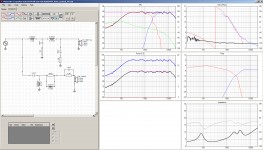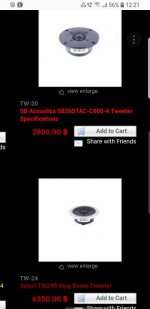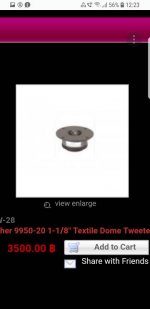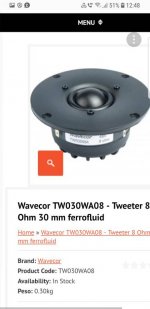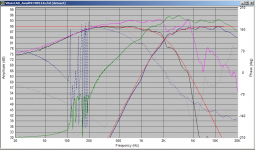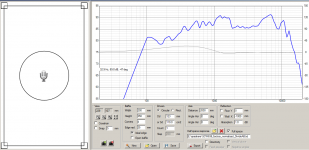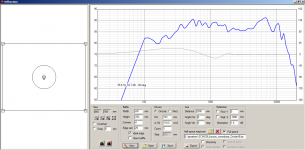Yeah I've been eyeing that woofer for a while, and the 8" version. I can't get them here, sadly. My choices are limited..
Mouser ships free to Thailand for orders over $50. 😉 🙂
TIW 250 XS - 8 Ohm Visaton | Mouser ไทย
Last edited:
Well, that's interesting, thanks! The killer is thai customs duty, but if the shipping is free it certainly sweetens it.
Current thoughts for a 3 way. Morel SCW636 with these
SW223BD02_03
The 8 ohm is suited to sealed (40hz f3)and the small cab size w 2 in parallel really appeals. Sensitivity is not great, but with floor gain, maybe 85-86db. This actually suits the Morel quite well for a 275hz crossover.
SW223BD02_03
The 8 ohm is suited to sealed (40hz f3)and the small cab size w 2 in parallel really appeals. Sensitivity is not great, but with floor gain, maybe 85-86db. This actually suits the Morel quite well for a 275hz crossover.
Last edited:
Well, that's interesting, thanks! The killer is thai customs duty..
-with various fees it seemed to be about 20% (when looking over their website). That's not so bad.
(..shipping + sales tax in the US would often be more.) 🙁
(..still, moot if you are going with the Wavecore.) 😱
If they see a 'farang' name, they charge more.. [emoji23] no rules here.-with various fees it seemed to be about 20% (when looking over their website). That's not so bad.
(..shipping + sales tax in the US would often be more.) 🙁
(..still, moot if you are going with the Wavecore.) 😱
Will go visit the wavecor guy today, see what the cost and availablity are.
I was wondering about tweets. I have spare Tlab tweets in London but won't be back there for a while...a lot tougher to do tweeter integration with the (Morel) woofer versions (..unless "active").
..a lot tougher to do tweeter integration with the (Morel) woofer versions (..unless "active").
Time alignment due to the shallow cones??
Wasn't an issue for me with the MW144's combined with DMS37 tweeter (CAT 378 now) https://www.morelhifi.com/wp-content/uploads/2013/11/CAT378.pdf That combo with tweeter flush and mw144's proud is time aligned.... not sure what the offset would be with the bigger tiw's
New version of the crossover that I've been working on attached.
Tony.
Attachments
The Morel SCW636 has an upper-mid. "bump" - it's actually useful if the baffle is really no wider than the Morel driver itself.. OR if the baffle is more than about 17 inches wide. Other than that though - it causes problems.
On top of that, dispersion isn't as good as the mid.s - making it slightly more difficult for anything but a wave-guide loaded tweeter.. OR a steep crossover just below where the driver becomes more directive.
https://www.morelhifi.com/wp-content/uploads/2013/11/SCW636.pdf
In both cases it can be done - it will just require more work *depending on the design*.
On top of that, dispersion isn't as good as the mid.s - making it slightly more difficult for anything but a wave-guide loaded tweeter.. OR a steep crossover just below where the driver becomes more directive.
https://www.morelhifi.com/wp-content/uploads/2013/11/SCW636.pdf
In both cases it can be done - it will just require more work *depending on the design*.
I was wondering about tweets. I have spare Tlab tweets in London but won't be back there for a while.
TL's great, and beyond that there is a lot of variety (depending on the design).
..most obvious that comes to mind: SB26ADC-C000-4.
SB Acoustics SB26ADC-C000-4 | HiFiCompass
The Morel SCW636 has an upper-mid. "bump" - it's actually useful if the baffle is really no wider than the Morel driver itself.. OR if the baffle is more than about 17 inches wide. Other than that though - it causes problems.
Ah, looking at that response curve I know exactly what you mean! It has the same problematic 1 to 2Khz hump that I got with my combination of baffle geometry and drivers (though I also have a massive suck out at 2Khz as well), and it did cause me a lot of grief!
2nd order acoustic slope I gave up on and went for 4th order acoustic. My original crossover was at 2.8Khz and has two parallel notches on the MW144's to tame it. I've been using that crossover for the last 6 years I guess, but just recently decided to try a lower crossover point. (posted above) and yes I'm using a semi-horn loaded tweeter, a low crossover point and a steepish slope 😉
Tony.
Wd the combination of a lowish x/o point around 1.8hz and curved baffle sides (a la Magico) help? And maybe baffle shape similar to the Marten Coltrane
Last edited:
The main problem is that a narrow baffle speaker tends to have a hump in the 1 - 2Khz range, if your driver has a dip in this range that works to your advantage, but when the driver also has a hump in that range the two add together.
For this particular woofer, I'm guessing you could probably end up with about an 8db hump somewhere between 1 - 2Khz. What's worse is that it is quite wide, so normal notch filters can bring it down a bit but won't eliminate it.
Looking at all of the 6" drivers in the titanium lineup, from a purely crossover friendly pov I would say that the TiW638Ft looks the easiest.
Funnily enough my latest measurements don't have the 1-2Khz hump that my earlier ones did, which probably means I stuffed up the original measurements and was continually trying to design out something that wasn't really there 🙄
Do some simulations of the baffle step, you can add it to an spl trace of the factory curve to see how it will effect the drivers response. You will generally need a pretty big radius to make any significant difference.
Attached is a pic of what my raw drivers looked like and with crossover (these sum to the post I did of my current crossover in progress). So it gives an idea of how a pretty ragged looking response can be shaped into something not too bad.
Note I haven't actually built this version of the crossover yet, so can't say if it is a success or not, but I lived with the previous one designed completely with sims and real measurements for 6+ years, so I'm reasonably confident it will work out ok.
Tony.
For this particular woofer, I'm guessing you could probably end up with about an 8db hump somewhere between 1 - 2Khz. What's worse is that it is quite wide, so normal notch filters can bring it down a bit but won't eliminate it.
Looking at all of the 6" drivers in the titanium lineup, from a purely crossover friendly pov I would say that the TiW638Ft looks the easiest.
Funnily enough my latest measurements don't have the 1-2Khz hump that my earlier ones did, which probably means I stuffed up the original measurements and was continually trying to design out something that wasn't really there 🙄
Do some simulations of the baffle step, you can add it to an spl trace of the factory curve to see how it will effect the drivers response. You will generally need a pretty big radius to make any significant difference.
Attached is a pic of what my raw drivers looked like and with crossover (these sum to the post I did of my current crossover in progress). So it gives an idea of how a pretty ragged looking response can be shaped into something not too bad.
Note I haven't actually built this version of the crossover yet, so can't say if it is a success or not, but I lived with the previous one designed completely with sims and real measurements for 6+ years, so I'm reasonably confident it will work out ok.
Tony.
Attachments
This is what vituix cad comes up with for a 200mm X 350mm baffle with 1" radius corners.
Factory traced curve (rather roughly) with iec baffle subtracted (and extraplolated down to 20Hz).
edit: 2nd with 17" baffle as per Scott's comment.
Tony.
Factory traced curve (rather roughly) with iec baffle subtracted (and extraplolated down to 20Hz).
edit: 2nd with 17" baffle as per Scott's comment.
Tony.
Attachments
Last edited:
I very much like the STAC from SB - quite detailed, but a bit "noisy"/"hash" (..which is part of the reason they sound so detailed). This isn't a non-linear distortion quality, but rather a linear distortion: it's not as damped near its surround as their ring varieties. The ring versions (including the Satori) are clean and clear, but don't present as much low-level detail, "air", or depth IMO (though the Satori's better rear "pathing" is similar in this respect). And of course all of the ring-types are limited in excursion by comparison.
Best descriptor for the STAC is "electrostatic" (..which typically also have similar "hashy" results in the treble). This character should work very well with the carbon Morel (..which is similar objectivly and subjectivly).
Of course as you go lower in freq. nearing 1 kHz, this quality is less pronounced.
The only caveat here is that you are more limited to the type of filter you would need for the tweeter relative to its crossover freq.. (..and it's why the "easy" recomend is the SB aluminum dome.)
Last edited:
edit: 2nd with 17" baffle as per Scott's comment.
Tony.
It's just a guess on my part when looking at wavelengths and knowing how baffles react. 😱
-does look pretty easy to work with though! 🙂 (..both lower in freq. and higher. Probably 2.5 kHz for the tweeter.)
I thought that the repsonse looked pretty good with that wide baffle! 🙂 I wondered whether you had actually simmed it! I couldn't have eyeballed it and come up with a figure.
Tony.
Tony.
It's not difficult.
..the "bump" starts at around 900 Hz. Drop the freq. by at least 100 hz, preferably a bit more. BUT, 800 Hz as a starting point and put that into a wavelength calculator:
Wavelength
It's a guesstimate, but not a bad one.
..the "bump" starts at around 900 Hz. Drop the freq. by at least 100 hz, preferably a bit more. BUT, 800 Hz as a starting point and put that into a wavelength calculator:
Wavelength
It's a guesstimate, but not a bad one.
- Home
- Loudspeakers
- Multi-Way
- Anyone tried the Morel titanium advanced woofer line?
